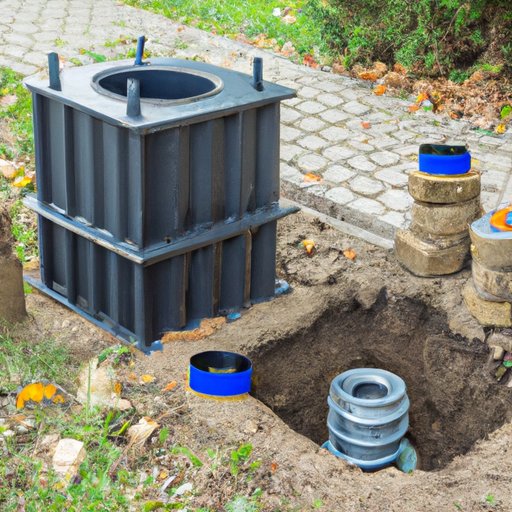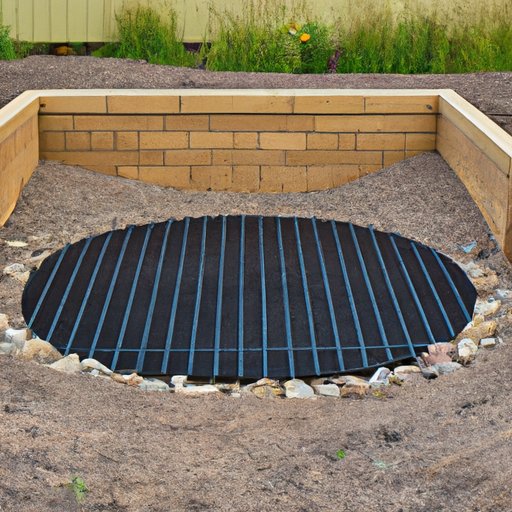Introduction
A dry well is a shallow pit dug into the ground that is used to collect and store stormwater runoff. It works by allowing the water to slowly seep into the surrounding soil, which helps to reduce flooding, prevent erosion, and improve water quality. Dry wells can be a great addition to any landscape plan as they provide an efficient way to manage stormwater runoff.

A Comprehensive Guide to Understanding and Maintaining a Dry Well
Before you begin installing a dry well, it’s important to understand the different types available and how to properly maintain them. Below is a comprehensive guide to understanding and maintaining a dry well.
Types of Dry Wells
There are several types of dry wells available. According to the US Environmental Protection Agency (EPA), “the most common type of dry well is a porous-walled chamber made of plastic or concrete, with openings on the sides and bottom.” These chambers are designed to allow water to enter and exit freely. Other types of dry wells include gravel-filled pits, perforated pipes, and rock-filled trenches.
Maintenance Tips
To ensure that your dry well is functioning properly, it’s important to regularly inspect and clean it. The EPA recommends inspecting your dry well at least once a year. During this inspection, look for any signs of clogging or damage. You should also check for any debris that may have built up in the dry well. If there is debris present, use a garden hose to flush it out. Additionally, it’s important to make sure that the dry well is not located too close to trees or other vegetation, as roots can clog the dry well and cause it to malfunction.

How to Install a Dry Well for Effective Stormwater Management
Installing a dry well is relatively easy and can be done in a few simple steps. Here’s what you need to know before getting started.
Tools Needed
Before you begin installing a dry well, you’ll need to gather the necessary tools and materials. These include a shovel, a tape measure, a level, a hammer, nails, stakes, a post hole digger, a wheelbarrow, a tarp, and a sump pump (if needed).
Step-by-Step Instructions
Once you have all the necessary tools and materials, follow these step-by-step instructions to install your dry well.
- Dig a hole that is 3-4 feet deep and 2-3 feet wide.
- Line the bottom of the hole with crushed stone or gravel.
- Place the dry well in the center of the hole and use a level to make sure it is even.
- Fill the remaining space around the dry well with crushed stone or gravel.
- Cover the dry well with a tarp and secure it with stakes.
- If needed, connect a sump pump to the dry well to help speed up the water absorption process.
The Pros and Cons of Using a Dry Well in Your Landscaping Plans
When considering whether or not to use a dry well in your landscaping plans, it’s important to weigh the pros and cons. Here’s what you need to know.
Advantages
Dry wells offer several advantages when it comes to stormwater management. They are relatively inexpensive to install and maintain, and they can help reduce flooding, erosion, and water pollution. Additionally, dry wells are aesthetically pleasing and can add value to your property.
Disadvantages
One potential disadvantage of using a dry well is that it can take some time for the water to be absorbed into the ground. This can lead to standing water in the dry well, which can create a breeding ground for mosquitoes. Additionally, if the dry well is not properly maintained, it can become clogged with debris, leading to ineffective stormwater management.

How to Choose the Right Size and Type of Dry Well for Your Needs
When selecting a dry well for your landscaping plans, it’s important to consider both size and type. Here are some things to keep in mind.
Considerations for Size
The size of the dry well you choose will depend on the amount of stormwater runoff you anticipate. According to the EPA, “a dry well should be large enough to accommodate the total volume of runoff from the area being drained.” For small areas, a 4-foot wide by 4-foot deep dry well should suffice. For larger areas, a 6-foot wide by 6-foot deep dry well is recommended.
Considerations for Type
The type of dry well you choose will depend on your specific needs. As mentioned earlier, the most common type of dry well is a porous-walled chamber. These are typically made of plastic or concrete and come in a variety of sizes. Gravel-filled pits, perforated pipes, and rock-filled trenches are other options to consider.
Conclusion
Dry wells are an effective way of managing stormwater runoff. They are relatively easy to install and maintain, and can help reduce flooding, erosion, and water pollution. When selecting a dry well for your landscaping plans, it’s important to consider both size and type. With the right dry well, you can create a safe and attractive landscape that is free of excess water.
Summary
Dry wells are an effective way of managing stormwater runoff. This comprehensive guide covered the different types of dry wells, how to install them, their advantages and disadvantages, how to choose the right size and type for your needs and other essential maintenance tips. With the right dry well, you can create a safe and attractive landscape that is free of excess water.
Final Thoughts
Dry wells are a great addition to any landscape plan. They are relatively easy to install and maintain, and can help reduce flooding, erosion, and water pollution. However, it’s important to inspect and clean the dry well regularly to ensure it is functioning properly. By following the tips outlined in this comprehensive guide, you can enjoy the many benefits of having a dry well in your landscape.
(Note: Is this article not meeting your expectations? Do you have knowledge or insights to share? Unlock new opportunities and expand your reach by joining our authors team. Click Registration to join us and share your expertise with our readers.)
